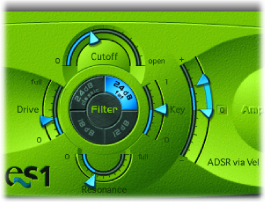Using the ES1 Filter Parameters
This section outlines the filter parameters of the ES1.

- Resonance slider: Cuts or boosts the portions of the signal that surround the frequency defined by the Cutoff parameter. Boost can be set so intensively that the filter begins to oscillate by itself (see Driving the ES1 Filter to Self-Oscillation).
Tip: You can simultaneously adjust the cutoff frequency and resonance parameters by dragging vertically (cutoff) or horizontally (resonance) on the word Filter, found between the Slope buttons.
- Slope buttons: The lowpass filter offers four different slopes of band rejection above the cutoff frequency. The four settings are arranged clockwise from the top left, as follows:
- 24 dB classic: Mimics the behavior of a Moog filter. Turning up the resonance results in a reduction of the low end of the signal.
- 24 dB fat: Compensates for the reduction of low frequency content caused by high Resonance values. This resembles the behavior of an Oberheim filter.
- 12 dB: Provides a soft, smooth sound which is reminiscent of the early Oberheim SEM.
- 18 dB: Tends to resemble the filter sound of Roland’s TB-303.
- Key slider: Controls how strongly the keyboard pitch (the note number) modulates the filter’s cutoff frequency:
If Key is set to zero, the cutoff frequency won’t change, no matter which key you strike. This makes the lower notes sound relatively brighter than the higher ones.
If Key is set to maximum, the filter follows the pitch, resulting in a constant relationship between cutoff frequency and pitch. This mirrors the properties of many acoustic instruments where higher notes sound both brighter in tone and higher in pitch.
- ADSR via Vel slider: Determines how note velocity affects the filter cutoff frequency modulation—caused by the envelope generator (see Using the ES1 Envelope Parameters).
Driving the ES1 Filter to Self-Oscillation
You can make the ES1 filter output a sine wave by following the steps below. This will allow you to “play” the filter-generated sine wave with the keyboard.
Switch the Sub knob to OFF.
Move the Mix slider to the very bottom (Sub).
Turn the Resonance knob to the maximum position.